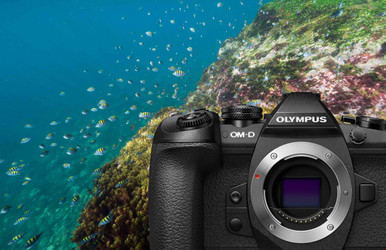Olympus E-M1 Mark II Camera Review
October 15th, 2018
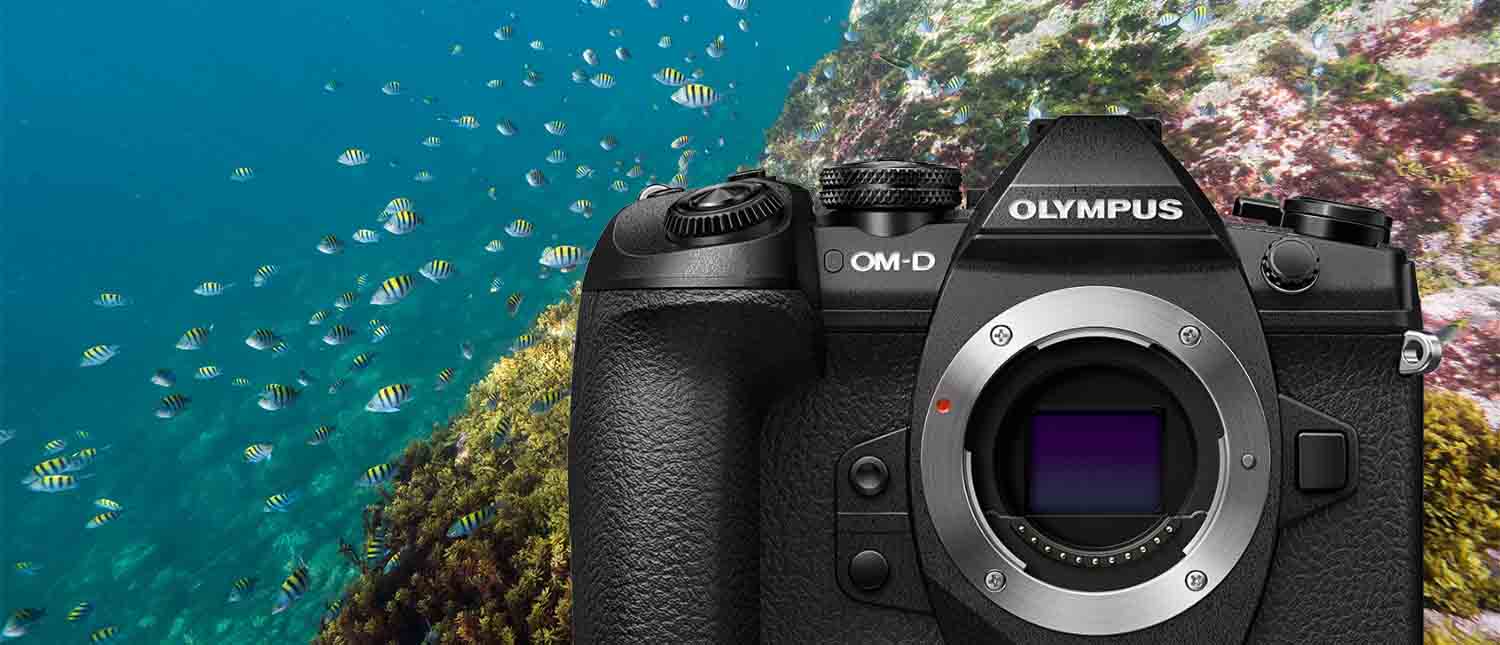
Olympus OM-D E-M1 Mark II Camera Review
The Olympus OM-D E-M1 Mark II is the top of the line micro four-thirds mirrorless camera. Released at the end of 2016 it built upon the long success of previous Olympus OM-D cameras, and offers professional level controls in a small, yet robust body. This camera offers the most flexibility and diversity of any mirrorless camera due to the large number of lens choices, the incredible amount of customizable camera options and the high quality output across a number of different shooting situations.
Features | Lens Recommendations | Housing Options
Underwater Settings | Comparison | Final Thoughts
Why We Love It
For underwater photographers the Olympus cameras have always been a dream to use and the E-M1 Mark II is no exception. Great lens selection allows the shooter to pick the perfect choice for the type of shot they want to capture. Easy to use controls translate to easy and accurate control from within an underwater housing, and the fully weather sealed body allows for rigorous use in less than ideal environments. Improvements in auto focus speed and accuracy, low light performance, and added customizable options make this a perfect choice for shooting in nearly every underwater scenario. The only downside to shooting underwater with the E-M1 Mark II is the lower 1/250th shutter speed sync (we saw up to 1/320th with the original E-M1), however this can easily be overcome with a Nauticam housing & flash trigger.
The Bottom Line: Choose the Olympus OM-D E-M1 Mark II if you want the best possible image quality from a smaller mirrorless camera. High speed burst, image resolution & quality, performance and controls set it above other similar mirrorless and put it nearly on par with many cropped sensor dSLR cameras. Unless you desire the increased detail of a full frame sensor, the E-M1 Mark II performs better than any other option of its class. It's good for the casual videographer, but limitations such as no custom white balance in video mode make it less ideal for serious video shooters.
Key Specs:
- 20 Megapixel Live MOS Sensor with TruPic VIII Dual Quad Processor
- Advanced 5-axis Image Stabilization
- 121-Point Dual Fast Autofocus
- 15 fps Sequential Shooting (Mechanical) / 60 fps Sequential Shooting (Electronic)
- 4K Cinema Video at 30/25/24 fps
- 1/250th Shutter Sync for flash
- Lightweight and Weatherproof Body
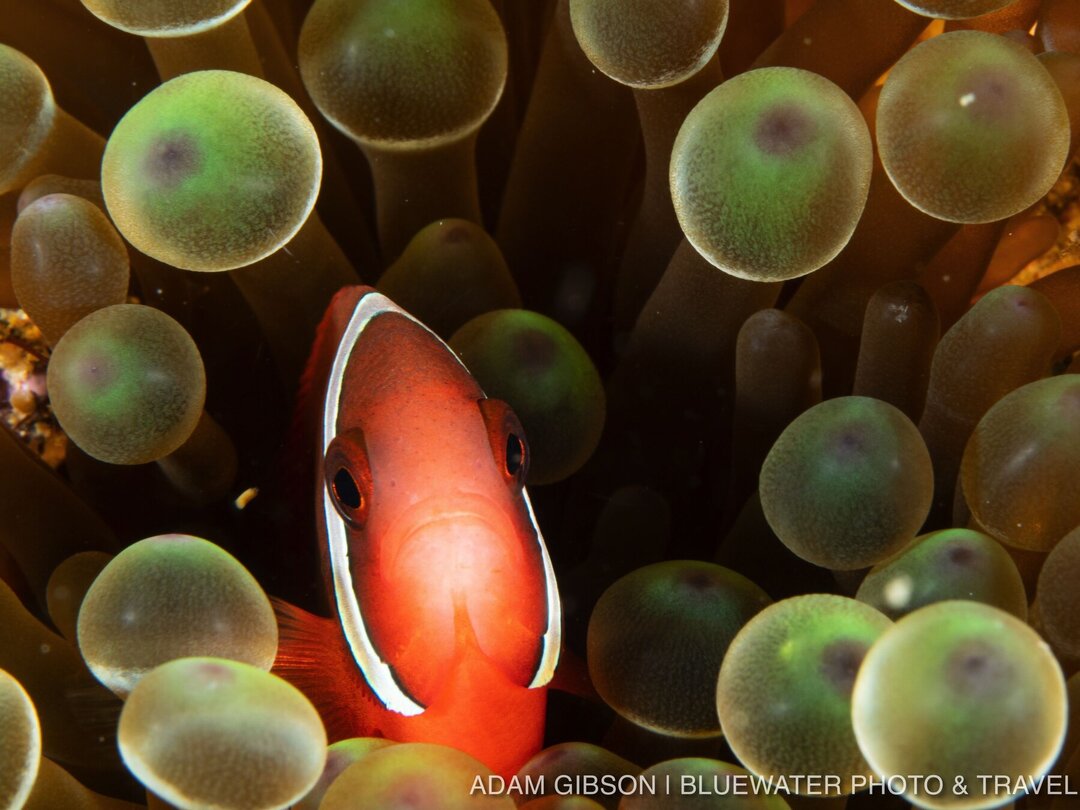
Anenomefish by Adam Gibson, OM-D E-M1 Mark II, Olympus 60mm macro lens.
E-M1 Mark II Features
Improved Resolution and Detail
The new 20MP Live MOS sensor brings a 25% increase in resolution from the previous OM-D cameras, which featured a 16MP sensor. In addition the E-M1 Mark II sensor does not have the anti-aliasing filter, which results in sharper, crisp images. Olympus continued to make improvements with ISO performance as well, with the E-M1 Mark II offering stellar low light performance with minimal grain. Here is a great comparison of the E-M1 Mark II, GH5 & A7R II for ISO performance. Overall grain is much less noticeable than previous OM-D cameras, and images remain useable even above ISO6400 (such as the ISO test shot to the left), which previously would be unheard of.
Extremely Fast Auto Focus
Major improvements in auto focus and tracking allow for more accurate focusing and quicker response time, especially with lenses such as the 60mm Macro. The E-M1 Mark II features 121 auto focus points allowing you to fine tune the focus location with greater accuracy.
Flash Sync Speed
With a flash sync speed of 1/250th, the E-M1 Mark II is on par with just about every other popular camera out now. While the original E-M1 featured a 1/320th sync speed, it ends up being a wash due to the improved ISO LOW setting at about ISO 64. The lower light sensitivity reduces incoming light allowing for more detail in bright spots despite not being able to stop down the shutter speed further.
Pro Tip: If shooting underwater with the Nauticam housing, we have learned that using their LED Flash Trigger allows you to bypass the 1/250th sync speed and shoot in sync images with strobes up to 1/500th! This will add greater flexibility for sun-balls and shots with bright light sources without sacrificing quality. (This was tested on YS-D2J strobes).
Lightning Fast Burst Shooting & Pro Capture Mode
Here is a place the E-M1 Mark II really shines. With an incredible 15fps using the mechanical shutter (locked focus) or 10fps with continuous autofocus. Both these specs are better than other similar cameras - the Panasonic GH5 offers up to 12fps and only 9fps with continuous autofocus and the Sony A7R III also offers 10fps with autofocus. Taking it one step further, the E-M1 Mark II offers up to 60fps when using the electronic shutter (autofocus locked). Grab a UHS-II card and get a nearly unlimited buffer allowing you to take full advantage of that 60fps burst!
Pro Capture mode is the same as shooting with the electronic shutter at 60 fps or 18 fps, but with the added benefit of “pre-capturing” photos from right before you press the shutter release. When engaged the camera begins storing photos in the internal memory while you hold focus. When you capture the shot it records up to 14 images (increased to 35 photos with the latest firmware update) from right before the shutter release and adds them to the front of your burst series. This allows you capture “perfect moment” action photos even if you are a bit late on hitting the shutter release. The one big limitation for using this mode underwater is the inability to use strobes - the burst rate is too quick to sync with strobes. However in the right conditions video lights would work great with this feature.
Image Stabilization - up to 5.5 stops
The 5-axis, in body image stabilization now offers up to 5.5 stops of control, meaning you can achieve a crisp image while shooting up to 5.5 stops slower than possible without the stabilization, giving the handheld shooter a much wider breadth of compositional control.
Professional Level Video
The E-M1 Mark II is the first of the OM-D line to include 4k video recording. Late the game, this is a much needed feature and one we're glad to see! 4K video is available at both 30fps and 24 fps with up to a 237 Mbps rate. The downside to shooting video with any Olympus OM-D camera is the lack of white balance control in video mode. This is nothing new to the E-M1 Mark II; all OM-D cameras so far have only allowed a custom white balance in photo mode. It's a bit of a roundabout work flow but you can preset and save white balances that can be selected in video mode later, otherwise you'll need to use a color correction filter or switch to photo mode to white balance then switch back to video.
Longer Battery Life, Fully Weather Sealed
Lastly improvements to the power system means a battery with 25% more shots per charge (up to 440 based on CIPA ratings) and a charging time that is 50% less than its predecessor. The magnesium and aluminum body are fully weather sealed, making this a great choice for shooting in less than ideal weather conditions.

Diving Sea Lion by Kelli Bortolin. OM-D E-M1 MK II, Oly 7-14mm Lens
E-M1 Mark II vs the Competition
Is the E-M1 Mark II the right option for you? Take a look at the specifications compared against other similar mirrorless cameras. The E-M1 Mark II excels in many areas including burst shooting, ISO, Image Stabilization and Battery Life. It compares similar to or a touch better than other micro-four third cameras for images, is great but not quite as good as the Panasonic GH5 for video performance, and offers incredible image detail and resolution, but is still a smaller sensor than the APS-C sized Sony A6500.
|
|
Olympus E-M1 Mark II |
Panasonic GH5 |
Sony A6500 |
Olympus E-M5 Mark II |
|
Price |
$1,699* |
$1,999 |
$1,299 |
$899 |
|
Max Resolution |
5184 x 3888 |
5184 x 3888 |
6000 x 4000 |
4608 x 3456 |
|
Effective Pixels |
20 MP |
20 MP |
24 MP |
16 MP |
| Sensor Size |
Micro Four Thirds (17.3 x 13mm) |
Micro Four Thirds (17.3 x 13mm) |
APS-C (23.5 x 15.6mm |
Micro Four Thirds (17.3 x 13mm) |
|
ISO |
Auto, 200-25600 (Expands to 64) |
Auto, 200-25600 (Expands to 100) |
Auto, 200-25600 (Expands to 100) |
Auto, 200-25600 (Expands to 100) |
|
Custom White Balance |
Yes (4 Slots) |
Yes (4 Slots) |
Yes (4 Slots) |
Yes (4 slots) |
|
Image Stabilization |
5 Axis, up to 5.5 stops shake reduction; 6.5 with compatible lenses |
5 Axis, supports Dual IS 2, up to 5 stops with compatible lenses |
5 Axis |
5 Axis, up to 5 stops shake reduction |
|
Autofocus |
Contrast & Phase Detection, 121 pts |
Contrast Detection, 225 pts |
Contrast & Phase Detection, 425 pts |
Contrast Detection, 81 pts |
|
Flash Sync Speed |
1/250 |
1/250 |
1/160 |
1/250 |
|
Burst Shooting |
60 fps electronic / 15 fps mechanical |
12 fps |
11 fps |
10 fps |
|
Video Formats |
MPEG-4, H.264, Motion JPEG |
MPEG-4, AVCHD, H.264 |
MPEG-4, AVCHD, XAVCS |
MPEG-4, H.264, Motion JPEG |
|
Max Video Resolution |
4096 x 2160 (24p) | 4096 x 2160 (24p) | 3840 x 2160 (30p) | 1920 x 1080 (60p) |
|
LCD Screen Size |
3” fully articulated |
3.2” fully articulated |
3” Tilting |
3” fully articulated |
|
Screen Dots |
1,037,000 |
1,620,000 |
921,600 |
1,037,000 |
|
Electronic Viewfinder |
100% Coverage at 0.74x magnification |
100% Coverage at 0.76x magnification |
100% Coverage at 0.71x magnification |
100% Coverage at 0.74x magnification |
|
Viewfinder Resolution |
2,360,000 |
3,680,000 |
2,360,000 |
2,360,000 |
|
Battery Life (CIPA) |
440 |
410 |
350 |
310 |
|
Weight |
574 g (1.27 lb / 20.25 oz) |
725 g (1.60 lb / 25.57 oz) |
453 g (1.00 lb / 15.98 oz) |
469 g (1.03 lb / 16.54 oz) |
|
Dimensions |
134 x 91 x 67 mm (5.28 x 3.58 x 2.64″) |
139 x 98 x 87 mm (5.47 x 3.86 x 3.43″) |
120 x 67 x 53 mm (4.72 x 2.64 x 2.09") |
124 x 85 x 45 mm (4.88 x 3.35 x 1.77″) |
* - The E-M1 Mark II originally sold for $1,999, but is now priced by Olympus at the much more competitive $1,699.
Best Lenses with the Olympus OM-D E-M1 Mark II
As mentioned previously, there is a wide range of quality lens choices for using the E-M1 Mark II underwater. This gives the shooter flexibility in choosing different focal lengths for both macro and wide lenses with multiple options for each style of lens. Since both Olympus and Panasonic use the micro four-thirds mount, lenses from either manufacturer work well with the OM-D E-M1 Mark II. Our Micro Four-Thirds Lens Buyer's Guide has all the great lens choices listed, but here are our top three favorites for the E-M1 Mark II Camera.
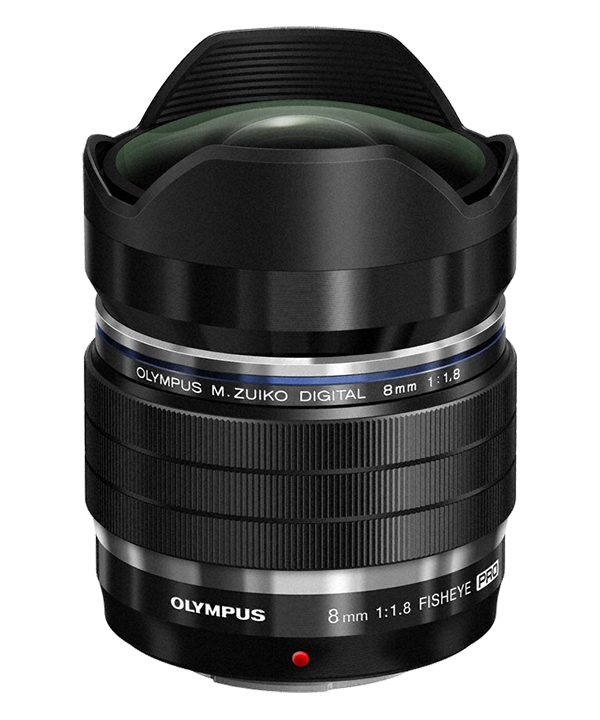
Olympus 8mm Fisheye Pro - We prefer this lens to the Panasonic 8mm Fisheye because it is slightly longer in length. Both lenses feature a wide 180° angle of view, but the extra physical length on the Olympus lens means that you have more space to position strobes without accidentally seeing them or the reflection glare in your images. This is the perfect lens for many wide angle scenarios and it excels at close focus wide angle.
 Olympus 60mm Macro - This is a favorite because of the level of magnification you can achieve while shooting. Comparable to a 120mm full frame macro lens, it works great for small to tiny critters & super macro with a diopter. The downside is medium to large subjects, like many fish, are too large and you have to move further away from the subject than is ideal. For more flexibility check out the Panasonic 45mm Macro.
Olympus 60mm Macro - This is a favorite because of the level of magnification you can achieve while shooting. Comparable to a 120mm full frame macro lens, it works great for small to tiny critters & super macro with a diopter. The downside is medium to large subjects, like many fish, are too large and you have to move further away from the subject than is ideal. For more flexibility check out the Panasonic 45mm Macro.
 Panasonic 7-14mm Wide Lens - This is an excellent choice for rectilinear wide angle. The super wide field of view is great for underwater and the quality is top notch. We often recommend the Panasonic lens to the Olympus 7-14mm PRO lens because of size. The Olympus version often has to be installed onto the camera from the front of the housing because it's diameter is too wide for most housing openings. This can be annoying, though overall quality of the Olympus is slightly better than the Panasonic. If budget is a concern, a great alternative to these lenses is the Olympus 9-18mm.
Panasonic 7-14mm Wide Lens - This is an excellent choice for rectilinear wide angle. The super wide field of view is great for underwater and the quality is top notch. We often recommend the Panasonic lens to the Olympus 7-14mm PRO lens because of size. The Olympus version often has to be installed onto the camera from the front of the housing because it's diameter is too wide for most housing openings. This can be annoying, though overall quality of the Olympus is slightly better than the Panasonic. If budget is a concern, a great alternative to these lenses is the Olympus 9-18mm.
Our Micro Four-Thirds Buyer's Guide outlines all the great lens choices we recommend for underwater use with the Olympus OM-D E-M1 Mark II.

Christmas Tree Worm, OM-D E-M1 Mark II, Olympus 60mm, F10, 1/100th
Underwater Housing Options
There are four great options to choose from when taking the Olympus OM-D E-M1 Mark II below the surface. Note - the E-M1 Mark II is not compatible with the original E-M1 underwater housings, and visa versa.

- Aquatica AE-M1MKII Housing
- Ikelite E-M1 Mark II Housing, 200DLM/B
- Nauticam NA-EM1II Housing
- Olympus PT-EP14 Housing
Each housing has unique features, but all four work great with the E-M1 Mark II. If shooting sun-balls or bursts underwater, or having a wide variety of dedicated add on accessories is most important for you, we recommend the Nauticam. Their flash trigger allows you to bypass the 1/250th camera sync and shoot at a faster shutter speed, great for getting back detail in sun-balls and for using strobes during burst shooting. The Aquatica is a rugged powerhouse - practically indestructible making it great for use in cold or rough environments. Both the Olympus and Ikelite are great for those on a budget or looking for a lighter weight housing for travel.
Check out our OM-D E-M1 Mark II Housing Buyer's Guide for the details on each housing.
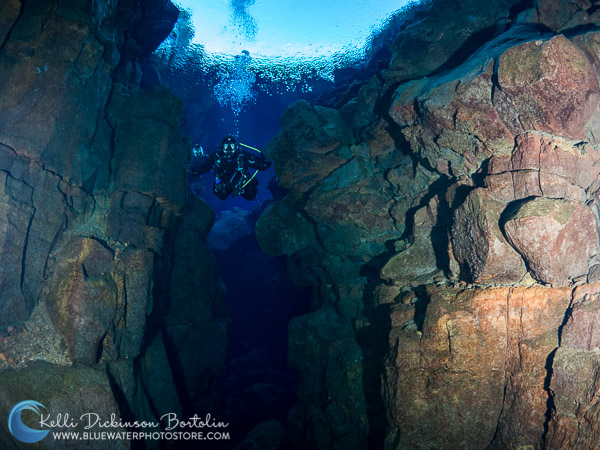
Diving Silfra by Kelli Bortolin. OM-D E-M1 Mark II, Oly 8mm F1.8 fisheye.
Underwater Settings for the Olympus OM-D E-M1 Mark II:
Check that these key functions are set on your camera before diving with your E-M1 Mark II.
-
Live View Boost - Select ON1
- With the E-M1 Mark II this is actually the default now.
-
EVF Auto Switch - OFF
- This function switches between the LCD and the Electronic Viewfinder when the camera is raised to your eye. If left on, only the EVF will display. Turn off to allow for manual selection of either viewing screen.
- Flash - When shooting with strobes do not forget to attach your flash or flash trigger.
Read through our comprehensive article on the Best Underwater Settings for the E-M1 Mark II for more useful tips and starting points when shooting with this camera underwater.
Shooting Macro:
Remember that aperture controls your depth of field, choosing a larger number aperture will mean more of the image will be in focus.
When shooting Macro with a strobe:
- Manual Mode
- Aperture between F16-22
- Shutter Speed 1/250th
- Auto White Balance
-
Strobe on TTL, Camera on Fill in Flash
- Position the strobe(s) slightly above your camera and facing down and slightly towards (but not directly at) the subject for good even lighting and shadows.
- If using a zoom lens and a diopter remember to zoom all the way in.
When shooting Macro with a video light:
- Manual Mode
- Aperture between F11-F22
-
Shutter Speed - start at 1/100th
- Change shutter speed to get the best exposure without blurring.
- Auto White Balance
-
Video Light on High Power
- Position it above and pointing down at your subject for best coverage.
- Get Close! Remember the Video light will not travel far through the water.
Shooting Wide Angle
Remember that shutter speed controls the amount of ambient light in the photograph. The faster the shutter speed, the less light in the background.
When shooting Wide Angle with a strobe:
- Manual Mode
- Aperture at F8
- Shutter Speed at 1/125th (adjust shutter speed to get a well exposed background)
- Auto White Balance
-
Camera on Fill in Flash, Strobe on TTL (or manual if preferred)
- Position dual strobes the same distance apart as you are from the subject (ie: 2ft from your subject, strobes are 2ft apart). Face them straight forward or slightly turned out to help eliminate backscatter.
When shooting Wide Angle with ambient light:
- Adjust your aperture and shutter speed from the settings above properly expose the foreground (ie: let in more light).
- Shoot with the sun behind you for better colors and less shadows.
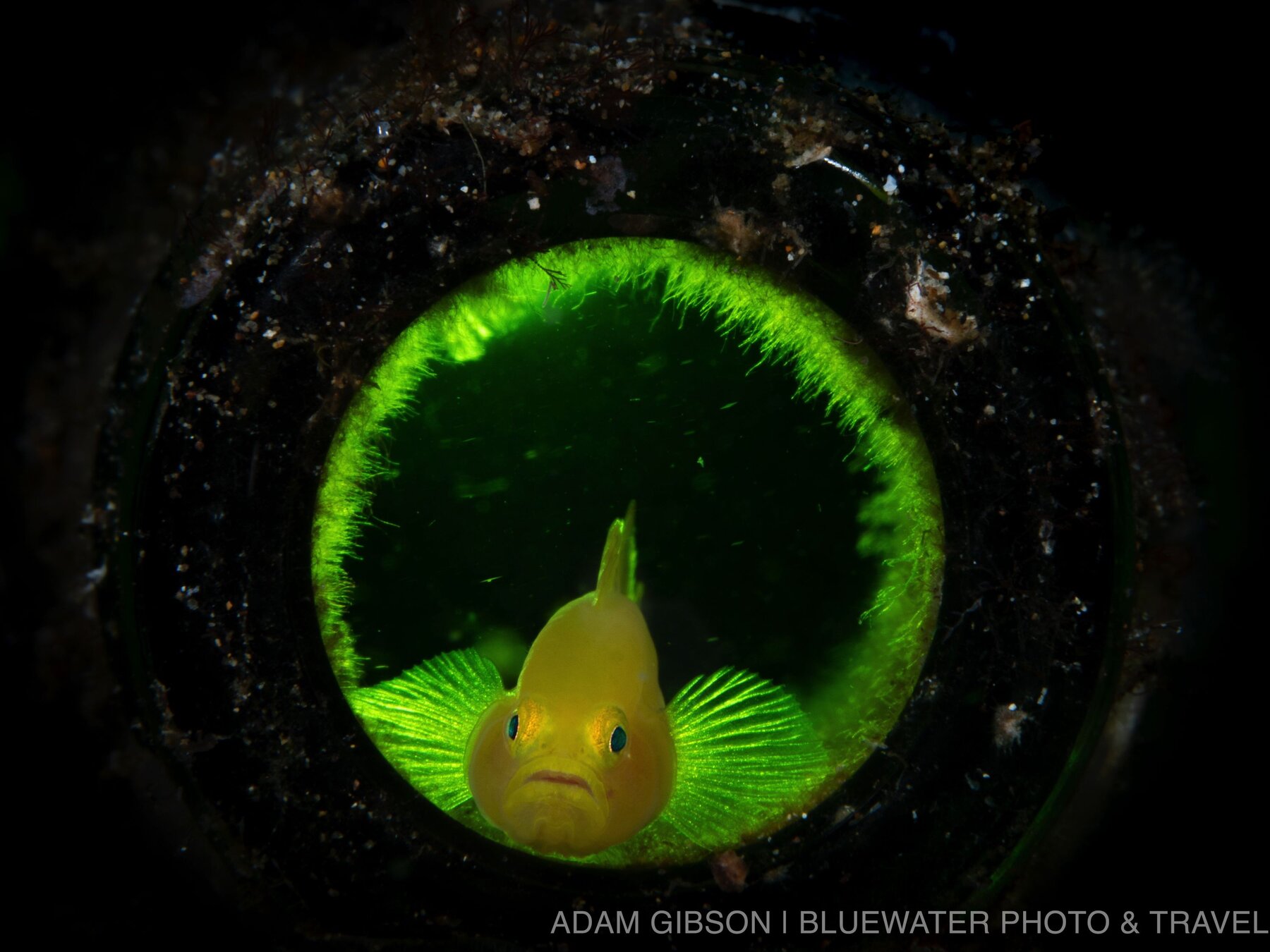
Final Thoughts:
The Olympus OM-D E-M1 Mark II offers the best possible image quality of the smaller mirrorless cameras. With great features such as lightning fast high speed burst shooting, improvements on image resolution, quality, performance and controls it sits above other similar mirrorless cameras and performs nearly on par with many cropped sensor dSLR cameras. Unless you desire the increased detail of a full frame sensor, the E-M1 Mark II performs better than any other option of its class. It's good for the casual videographer, but limitations such as no custom white balance in video mode make it less ideal for serious video shooters. Overall the wide selection of lens options make this a top choice for underwater photography.


